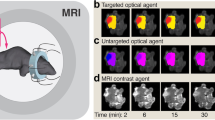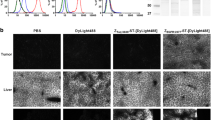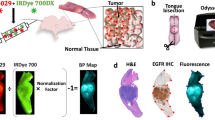Abstract
Purpose
Receptor availability represents a key component of current cancer management. However, no approaches have been adopted to do this clinically, and the current standard of care is invasive tissue biopsy. A dual-reporter methodology capable of quantifying available receptor binding potential of tumors in vivo within a clinically relevant time scale is presented.
Procedures
To test the methodology, a fluorescence imaging-based adaptation was validated against ex vivo and in vitro measures of epidermal growth factor receptor (EGFR) binding potential in four tumor lines in mice, each line expected to express a different level of EGFR.
Results
A strong correlation was observed between in vivo and ex vivo measures of binding potential for all tumor lines (r = 0.99, p < 0.01, slope = 1.80 ± 0.48, and intercept = −0.58 ± 0.84) and between in vivo and in vitro for the three lines expressing the least amount of EGFR (r = 0.99, p < 0.01, slope = 0.64 ± 0.32, and intercept = 0.47 ± 0.51).
Conclusions
By providing a fast and robust measure of receptor density in tumors, the presented methodology has powerful implications for improving choices in cancer intervention, evaluation, and monitoring, and can be scaled to the clinic with an imaging modality like SPECT.





Similar content being viewed by others
References
Weissleder R, Pittet MJ (2008) Imaging in the era of molecular oncology. Nature 452:580–589
Peer D, Karp JM, Hong S, Farokhzad OC, Margalit R, Langer R (2007) Nanocarriers as an emerging platform for cancer therapy. Nat Nanotechnol 2:751–760
Ntziachristos V, Tung CH, Bremer C, Weissleder R (2002) Fluorescence molecular tomography resolves protease activity in vivo. Nat Med 8:757–760
Weissleder R, Tung CH, Mahmood U, Bogdanov A Jr (1999) In vivo imaging of tumors with protease-activated near-infrared fluorescent probes. Nat Biotechnol 17:375–378
Chernomordik V, Hassan M, Lee SB, Zielinski R, Gandjbakhche A, Capala J (2010) Quantitative analysis of Her2 receptor expression in vivo by near-infrared optical imaging. Mol Imaging 9:192–200
Mintun MA, Raichle ME, Kilbourn MR, Wooten GF, Welch MJ (1984) A quantitative model for the in vivo assessment of drug binding sites with positron emission tomography. Ann Neurol 15:217–227
Lammertsma AA, Hume SP (1996) Simplified reference tissue model for PET receptor studies. Neuroimage 4:153–158
Logan J, Fowler JS, Volkow ND, Wang GJ, Ding YS, Alexoff DL (1996) Distribution volume ratios without blood sampling from graphical analysis of PET data. J Cereb Blood Flow Metab 16:834–840
Carmeliet P, Jain RK (2000) Angiogenesis in cancer and other diseases. Nature 407:249–257
Maeda H, Wu J, Sawa T, Matsumura Y, Hori K (2000) Tumor vascular permeability and the EPR effect in macromolecular therapeutics: a review. J Control Release 65:271–284
Goldenberg DM, Kim EE, DeLand FH, Bennett S, Primus FJ (1980) Radioimmunodetection of cancer with radioactive antibodies to carcinoembryonic antigen. Cancer Res 40:2984–2992
Hine KR, Bradwell AR, Reeder TA, Drolc Z, Dykes PW (1980) Radioimmunodetection of gastrointestinal neoplasms with antibodies to carcinoembryonic antigen. Cancer Res 40:2993–2996
Pogue BW, Samkoe KS, Hextrum S et al (2010) Imaging targeted-agent binding in vivo with two probes. J Biomed Opt 15:030513
Liu JT, Helms MW, Mandella MJ, Crawford JM, Kino GS, Contag CH (2009) Quantifying cell-surface biomarker expression in thick tissues with ratiometric three-dimensional microscopy. Biophys J 96:2405–2414
Samkoe KS, Sexton K, Tichauer KM, et al. (2011) High vascular delivery of EGF, but low receptor binding rate is observed in AsPC-1 tumors as compared to normal pancreas. Mol Imaging Biol. doi:10.1007/s11307-011-5203-5
Innis RB, Cunningham VJ, Delforge J et al (2007) Consensus nomenclature for in vivo imaging of reversibly binding radioligands. J Cereb Blood Flow Metab 27:1533–1539
Samkoe KS, Chen A, Rizvi I et al (2010) Imaging tumor variation in response to photodynamic therapy in pancreatic cancer xenograft models. Int J Radiat Oncol Biol Phys 76:251–259
Wikstrand CJ, McLendon RE, Friedman AH, Bigner DD (1997) Cell surface localization and density of the tumor-associated variant of the epidermal growth factor receptor, EGFRvIII. Cancer Res 57:4130–4140
Gibbs-Strauss SL, Samkoe KS, O'Hara JA et al (2010) Detecting epidermal growth factor receptor tumor activity in vivo during cetuximab therapy of murine gliomas. Acad Radiol 17:7–17
Smith JJ, Derynck R, Korc M (1987) Production of transforming growth factor alpha in human pancreatic cancer cells: evidence for a superagonist autocrine cycle. Proc Natl Acad Sci USA 84:7567–7570
Gunn RN, Lammertsma AA, Hume SP, Cunningham VJ (1997) Parametric imaging of ligand-receptor binding in PET using a simplified reference region model. Neuroimage 6:279–287
Baselga J, Pfister D, Cooper MR et al (2000) Phase I studies of anti-epidermal growth factor receptor chimeric antibody C225 alone and in combination with cisplatin. J Clin Oncol 18:904–914
Aerts HJ, Dubois L, Perk L et al (2009) Disparity between in vivo EGFR expression and 89Zr-labeled cetuximab uptake assessed with PET. J Nucl Med 50:123–131
McLarty K, Cornelissen B, Scollard DA, Done SJ, Chun K, Reilly RM (2009) Associations between the uptake of 111In-DTPA-trastuzumab, HER2 density and response to trastuzumab (Herceptin) in athymic mice bearing subcutaneous human tumour xenografts. Eur J Nucl Med Mol Imaging 36:81–93
Fujimori K, Covell DG, Fletcher JE, Weinstein JN (1990) A modeling analysis of monoclonal antibody percolation through tumors: a binding-site barrier. J Nucl Med 31:1191–1198
Jain RK, Baxter LT (1988) Mechanisms of heterogeneous distribution of monoclonal antibodies and other macromolecules in tumors: significance of elevated interstitial pressure. Cancer Res 48:7022–7032
Tolmachev V, Rosik D, Wallberg H et al (2010) Imaging of EGFR expression in murine xenografts using site-specifically labelled anti-EGFR 111In-DOTA-Z EGFR:2377 affibody molecule: aspect of the injected tracer amount. Eur J Nucl Med Mol Imaging 37:613–622
Franceschini MA, Gratton E, Hueber D, Fantini S (1999) Near-infrared absorption and scattering spectra of tissues in vivo. In Proceedings of SPIE
Acknowledgements
This research was funded by NIH grants P01CA84201, R01CA109558, and R01CA156177. K. M. T. was funded in part by a CIHR postdoctoral fellowship.
Conflicts of interest
The authors have no conflicts of interest.
Author information
Authors and Affiliations
Corresponding authors
Rights and permissions
About this article
Cite this article
Tichauer, K.M., Samkoe, K.S., Sexton, K.J. et al. In Vivo Quantification of Tumor Receptor Binding Potential with Dual-Reporter Molecular Imaging. Mol Imaging Biol 14, 584–592 (2012). https://doi.org/10.1007/s11307-011-0534-y
Published:
Issue Date:
DOI: https://doi.org/10.1007/s11307-011-0534-y




